

Skis, bindings, and boots get a lot of attention in the touring world, but don’t overlook your humble climbing skins. Most importantly, you want to match the design and materials to your local terrain and snow conditions to optimize performance. Some models utilize nylon to offer better friction for climbs, while others prioritize gliding quickly with mohair. Serious backcountry skiers will want an ultralight and packable build. Below, we’ve included all varieties in our picks of the best climbing skins for the 2024-2025 season. For further guidance, see our comparison table and buying advice below the picks.
Editor's note: We updated this guide on December 13, 2024, to revamp our coverage on all Pomoca offerings, move their Free Pro up as our favorite fast-and-light option, and add the Big Sky Mohair Mix Endurance to our list. We also tweaked the product rankings to reflect on-the-snow performance and added details about our testing process below the picks.
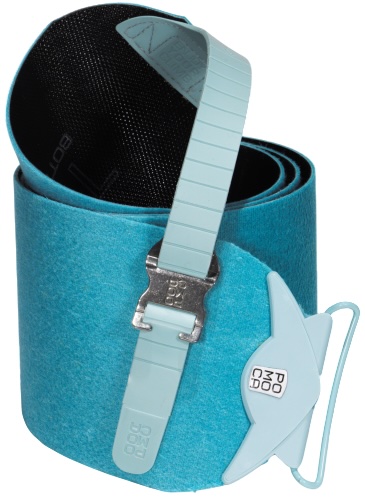 Weight: 15.8 oz. (110mm x 170cm)
Weight: 15.8 oz. (110mm x 170cm)
Materials: 65% mohair, 35% nylon
Widths: 100, 110, 120, 130, 140mm
What we like: An optimal balance of glide, grip, adhesion, and packability.
What we don’t: Has a shorter lifespan than 100%-nylon designs and the Contour Hybrid Mix below.
Although Pomoca has specialized in climbing skins since the 1930s, the Swiss company only entered the U.S. mainstream this past decade. And while they still lack the name recognition of Black Diamond or G3, their products are widely used: In fact, skins from many major ski brands—including backcountry powerhouses like DPS and Dynafit—are rebranded Pomoca designs. The Tour Pro is a great example of their expertise. Using a 65/35 mohair-nylon blend that both glides and grips well, it’s lightweight and has a suppleness that packs down small into a ski backpack or jacket. Skiers often rave about Pomoca’s glue, which is sticky enough to stay attached all day while releasing a bit more readily than other brands. And to get you started, their included trimming tool makes cutting new skins a breeze.
Pomoca’s skin lineup saw several changes this season, including new names, material tweaks, and feature updates. The Tour Pro here replaces their Climb Pro S-Glide and is now made with a little more mohair and a bit less nylon (the prior version was 70/30), which translates to slightly better glide. Pomoca also replaced the plastic tail clip with a metal one, addressing one of our primary durability concerns with the past model. That said, while it doesn’t require regular maintenance like the Contour Hybrid Mix below, the Pomoca’s glue isn't a standout in longevity. Neither is its 65%-mohair plush, which is less durable than nylon. But minor gripes aside, the Tour Pro is our top choice for most skiers and should last for many seasons to come. And if you’re looking for even more glide, check out Pomoca's 100%-mohair Tour Pro Cold below.
See the Pomoca Tour Pro Skins
 Weight: 1 lb. 10.0 oz. (133mm x 180cm)
Weight: 1 lb. 10.0 oz. (133mm x 180cm)
Material: 100% nylon
Width: 133mm
What we like: Long-lasting, grips well, and affordable.
What we don’t: Only comes in one width; fairly heavy and bulky.
Black Diamond’s Ascension is one of the most ubiquitous designs on the market, and for good reason. Rather than the nylon-mohair blend of our top pick above, the entry-level BD design uses 100%-nylon plush that’s incredibly durable and offers a more secure feel on steep skin tracks (at the sacrifice of glide in flat sections). In addition, the pre-installed and easy-to-adjust metal tip and tail clips are a nice bonus for new backcountry skiers trying to learn their way around unfamiliar gear. And at $190, the Ascension is a solid value considering the long-lasting construction that should see you through many seasons.
The Ascension is a direct competitor to the all-nylon G3 Escapist Universal below. Both skins run notably heavier and bulkier than momix (mohair and nylon blend) alternatives but are nevertheless great options for penny pinchers or those just starting out. And while the Ascension will cost you $30 more than the narrowest G3, the preinstalled hardware could be worth the extra money if DIY isn’t your thing. What's more, many skiers prefer BD’s cable toe loop over G3’s hook system (this will ultimately come down to a matter of preference and familiarity). We do wish the BD came in multiple widths to eliminate waste (most skis are much narrower than 133mm), and the fixed tail hardware is a pain to replace when the plastic notches blow out (which will likely happen after years of use). But for beginners and those who only get out a few times a year, the Ascensions offer a great combination of durability, user-friendliness, and price.
See the Black Diamond Ascension Skins
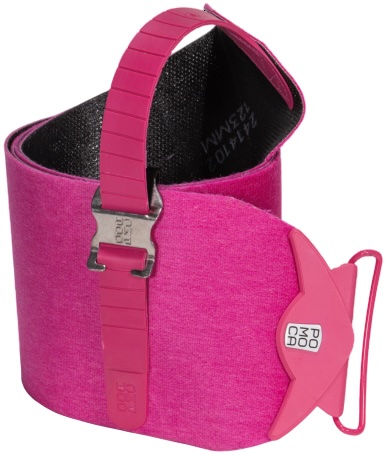 Weight: 15.2 oz. (123mm x 180cm)
Weight: 15.2 oz. (123mm x 180cm)
Materials: 70% mohair, 30% nylon
Widths: 123, 140mm
What we like: An incredibly lightweight and packable skin for freeriders and ski mountaineers alike.
What we don’t: Some freeriders might want a beefier and more durable skin.
For ski mountaineers and other ounce-counters focused on keeping weight to a minimum, the Pomoca Free Pro skin offers a hard-to-beat combination of performance, weight, and packability. Despite having a similar momix blend as their all-around Tour Pro above (70% mohair, 30% nylon), the Free Pro checks in at a lower weight (its plush weighs 1,000 grams per square meter compared to the Tour Pro's 1,200 g/m²) and features a noticeably smaller packed size. It also offers more glide and less grip, which is a suitable arrangement for experienced skiers or those factoring in the larger surface area of fat skis. And like the Tour Pro, the Free Pro saw some notable updates for this season, including swapping the plastic tip for metal to boost durability (importantly, this didn't have a notable impact on weight).
The Free Pro is one of the lightest and most packable skins on our list, but this does come with some downsides. First and foremost is durability: More than most skins, the Free Pro will be more prone to wear, abrasions, and eventual failure after many seasons of hard use. What’s more, new backcountry skiers or those who consistently get out in icy conditions will want to think twice about opting for a skin with this little grip. But for freeride aficionados or expert skiers who want to keep it light, the Free Pro is a very intriguing offering from the Swiss brand. And if you’re a skimo racer, we recommend Pomoca’s 100%-mohair Race Pro, which is similarly light and comes in skinnier 59, 62, and 65-millimeter widths.
See the Pomoca Free Pro Skins
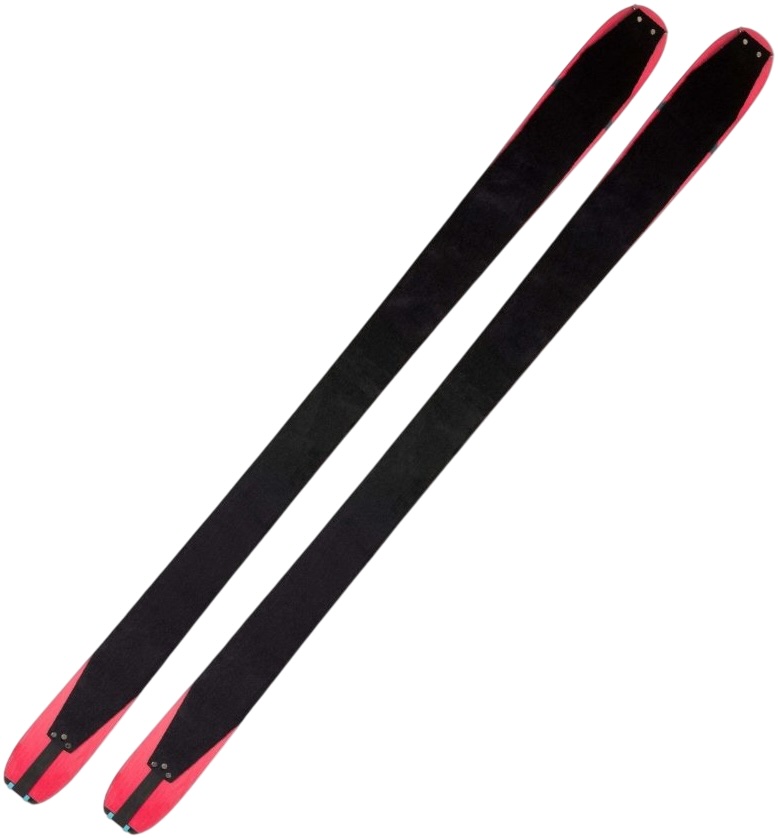 Weight: 12.3 oz. (98mm x 180cm)
Weight: 12.3 oz. (98mm x 180cm)
Material: 65% mohair, 35% nylon
Widths: 100, 110, 125, 140mm
What we like: Same material mix as the Tour Pro above in a lighter and cheaper package.
What we don’t: You can get better durability for around the same price with the all-nylon Ascension or G3 Escapist below.
Though Big Sky Mountain Products may lack the name recognition of big players like Pomoca, Black Diamond, and G3, this Boise-based brand has impressed us with their fun and well-rounded skins. The Mohair Mix Endurance is our current favorite for its excellent balance of price and performance. In fact, it features the same momix blend as our top-ranked Pomoca Tour Pro but is both lighter (by a few ounces) and cheaper (by $50 to $80 depending on size). Our Montana-based ski editor has been a big fan of the Big Sky skins for many seasons now, praising their grip and glide as comparable to pricier options on our list. Plus, Big Sky offers some fun and unique prints, including pineapples and a neon green "Retro" pattern (the Mohair Mix Endurance is offered in a solid but classy black design).
However, in our experience, the Mohair Mix Endurance falls short of the Tour Pro in one key area: durability. While plenty hardwearing for most uses, the lightweight Big Sky is more prone to wear in tough conditions compared to the Pomoca skins, which may necessitate earlier replacement. Additionally, Big Sky has a somewhat limited distribution—you won't find their skins available through popular ski and snowboard retailers like Evo, REI Co-op, or Backcountry (though Big Sky offers both domestic and international shipping through their website, and we've seen their skins in many local ski shops). Finally, it's worth noting that you can get better durability and grip for around the same price with all-nylon alternatives like the BD Ascension above or G3 Escapist below. But if you're looking for the well-rounded performance of a momix blend without breaking the bank, the Big Sky could be just the ticket.
See the Big Sky Mohair Mix Endurance Skins
 Weight: 1 lb. 9.7 oz. (135mm x 180cm)
Weight: 1 lb. 9.7 oz. (135mm x 180cm)
Materials: 65% mohair, 35% nylon
Widths: 110, 135mm
What we like: Great mix of performance, convenience, and price.
What we don’t: Not our favorite glue.
Black Diamond is one of the biggest names in climbing and skiing, and their skins live up to that reputation. Using a mix of mohair and nylon, the Glidelite Mix balances smooth and fast forward glide with secure uphill travel. And with a fairly recent update, the materials are lighter, softer, and more flexible than before. An adjustable tail on the "Fixed Length" version means less DIY out of the box, and the metal tail clip attachment makes the plastic piece easy to replace if and when its notches blow out. Finally, in terms of purchasing options, the Glidelite Mix Fixed Length is available in two widths, each of which come with pre-installed hardware for four fixed lengths.
Our main gripe with the Glidelite is Black Diamond's glue, named "Gold Label Adhesive." We've had mixed experiences: On one hand, it's quite aggressive—it can take a lot of effort to pull your skins apart when you’re ready to start climbing. On the other hand, we've found that the glue globs up and requires a bit more maintenance than other blends, including stripping the skins completely and reapplying. Adhesive aside, the rest of the skin is well sorted: We're big fans of Black Diamond's replaceable STS tail hardware (the previous version's riveted tails were a pain to fix), and the revamped trimming tool is the best we've used. All told, the Glidelite's balance of performance, price, and durability makes it a top contender in the climbing skins market.
See the Black Diamond Glidelite Mix Fixed Length
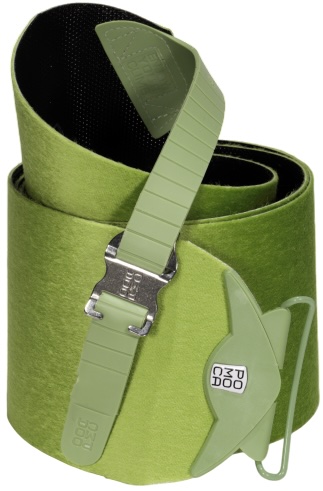 Weight: 15.8 oz. (110mm x 170cm)
Weight: 15.8 oz. (110mm x 170cm)
Materials: 100% mohair
Width: 120mm
What we like: Great glide and grip in cold snow conditions.
What we don’t: Not as durable as nylon or nylon blends.
If you live in a cold climate such as Colorado or have a hut trip planned in the Canadian Rockies, the Pomoca Tour Pro Cold (formerly the Climb Pro Mohair) is a great addition to your touring kit. Mohair shines in cold snow conditions, and the Tour Pro Cold uses additional weaving techniques to ensure a confident grip without any negative impact on weight or glide. Further, you get Pomoca’s sticky-but-not-too-sticky glue that backcountry skiers have come to know and love, and the plush is treated to resist water absorption (and therefore gloppiness) in warmer temps. If you're in the market for a 100%-mohair daily driver, the Tour Pro Cold is well worth a closer look.
Of course, the all-mohair Tour Pro Cold makes compromises that a synthetic blend does not. For one, despite Pomoca’s weaving techniques and treatments, mohair will wear faster than a blend or all-nylon design. Additionally, in warmer climates where an icy skin track is par for the course, you’ll find superior grip with a momix blend, such as the 65/35 mix found in our top pick. Similarly, beginners will want to err on the side of grip and choose either a blend or a full nylon option like the Black Diamond Ascensions. That said, more experienced backcountry skiers and those covering a lot of ground in a day will find a lot to love in this light and supple climbing skin. Note: The Tour Pro Cold is tough to track down at the time of publishing (and can't be purchased directly through Pomoca's website), but we expect availability to improve in the coming months.
See the Pomoca Tour Pro Cold Skins
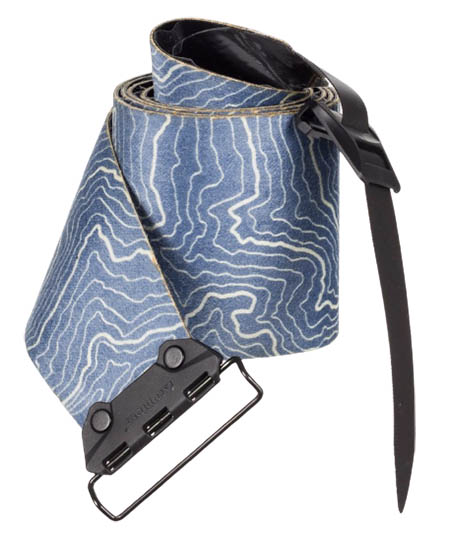 Weight: 1 lb. 6.0 oz. (115mm x 176cm)
Weight: 1 lb. 6.0 oz. (115mm x 176cm)
Materials: 70% mohair, 30% nylon
Widths: 115, 135mm
What we like: Performs on par with our top pick.
What we don’t: Requires regular maintenance to maximize its lifespan.
Austria-based Contour has more than 45 years of experience when it comes to climbing skins, and it shows in their Hybrid Mix here. Featuring a similar cocktail of mohair and nylon as the Tour Pro above, the Hybrid Mix offers a balanced combination of glide and grip—and for the most part, its performance is on par with our top pick. The main distinction is Contour’s hybrid glue, a unique technology that merges features from both standard (“hot melt”) and glueless skins. Over standard adhesives, hybrids adhere securely to your skis (even at low temperatures) and rip off easily when it’s time for the downhill. And here’s the true kicker: They are easy to revive with a simple wash (most skins require re-gluing).
Ironically, the Contour's hybrid glue is also what pushes it down our list. On one hand, we appreciate that the Hybrid Mix doesn't require regular re-gluing, but you'll want to clear the skins of debris before each use to maximize their performance. We've also found Contour's purpose-built cleaning spray to be the best solution for maintaining the glue over time—store-bought cleaning solutions simply don't get the job done (and, in some cases, have reportedly compromised the glue's integrity). Finally, we've had some issues with grip in cold weather. One of our testers equates the glue to silicone on a slick surface: While it sticks, it's not tacky, and the cold affects its ability to adhere to the bottom of the ski. In the end, we think the Tour Pro above is the better match for most, but the Contour Hybrid Mix will save you some cash and has a pretty solid reputation overall.
See the Contour Hybrid Mix Skins
 Weight: 1 lb. 7.6 oz. (140mm x 175cm)
Weight: 1 lb. 7.6 oz. (140mm x 175cm)
Material: 100% nylon
Widths: 50, 70, 100, 120, 140mm
What we like: A well-made, affordable option.
What we don’t: Less versatile than our top picks; you’ll have to install the tip hardware yourself.
High-quality skins can run you upwards of $200 (or more), but G3’s Escapist Universal is a nice way to save without making big compromises in performance. For $155 to $188 (depending on your ski length and width), you get a 100%-nylon skin, including well-designed tip and tail attachments. An all-nylon skin delivers long-lasting grip for traversing steep slopes and icy terrain, making the Escapist a secure and durable choice for those still gaining experience on the skin track.
What do you sacrifice with a budget design like the Escapist? First, when it comes to versatility, the Escapist can't hold a candle to the top-ranked Pomoca Tour Pro and even falls short of the Black Diamond Ascension, which also uses an all-nylon build. In our experience, the G3 skins are quick to glop up in heavy, wet snow, and we've been a little underwhelmed by their adhesion. Another notable downside is that you'll have to install the tip hardware yourself. Just a few years ago, this was routine when purchasing a new set of skins, but with more and more custom lengths on the market, it’s now an extra step you certainly don’t want to mess up. Thankfully, G3 makes it rather straightforward, and the rest of the process is quite simple (including using their excellent trim tool for the edges). But for just a small bump in price, we think the Black Diamond Ascension is the better all-nylon design.
See the G3 Escapist Universal Skins
| Skin | Price | Materials | Weight | Widths |
|---|---|---|---|---|
| Pomoca Tour Pro | $230-$260 | 65% mohair, 35% nylon | 15.8 oz. | 100, 110, 120, 130, 140mm |
| Black Diamond Ascension | $190 | 100% nylon | 1 lb. 10.0 oz. | 133mm |
| Pomoca Free Pro | $250-$260 | 70% mohair, 30% nylon | 15.2 oz. | 123, 140mm |
| Big Sky Mohair Mix Endurance | $180-$210 | 65% mohair, 35% nylon | 12.3 oz. | 100, 110, 125, 140mm |
| Black Diamond Glidelite Mix | $210-$220 | 65% mohair, 35% nylon | 1 lb. 9.7 oz. | 110, 135mm |
| Pomoca Tour Pro Cold | $219 | 100% mohair | 15.8 oz. | 120mm |
| Contour Hybrid Mix | $200-$220 | 70% mohair, 30% nylon | 1 lb. 6.0 oz. | 115, 135mm |
| G3 Escapist Universal | $155-$188 | 100% nylon | 1 lb. 7.6 oz. | 50, 70, 100, 120, 140mm |
Climbing skins are a vital part of any backcountry touring kit, whether you’re taking yo-yo laps at a local powder stash or tackling springtime volcano ascents. In fact, one of our more recent testing trips took us to Mount Rainier, where we tested a variety of ski gear (including skins) on the Paradise Glacier. In evaluating performance, we take several considerations into account, starting with overall quality. We pay close attention to the material mix, glue, and hardware, putting each skin through its paces in different environments and snow conditions, from windswept slopes to powder-laden forests. We also evaluate performance off the slopes, paying attention to how much maintenance each skin requires and taking note of any durability issues that crop up over time.
The lineup of eight climbing skins you see above is the result of ongoing testing as well as feedback from longtime contributors and the online ski community. Our first iteration of the guide was published in 2020 with eight options hand-picked by former senior editor Jenny Abegg and gear tester Alli Hartz. Based in Washington state, Jenny arguably spends more time in the mountains than she does at home, with the North Cascades being her local playground. Alli is based in Bend, Oregon, and splits her time between ski guiding and avalanche education in the winter months. Editors Maddie Downie and Brooke Maushund took over the guide in 2024, bringing their combined decades of backcountry experience to the table, from local romps in the Pacific Northwest to far-off adventures in southern Patagonia (Brooke's most recent post as an avalanche forecaster). As the market continues to change, we'll be sure to update our picks above to reflect standout performers and new innovations.
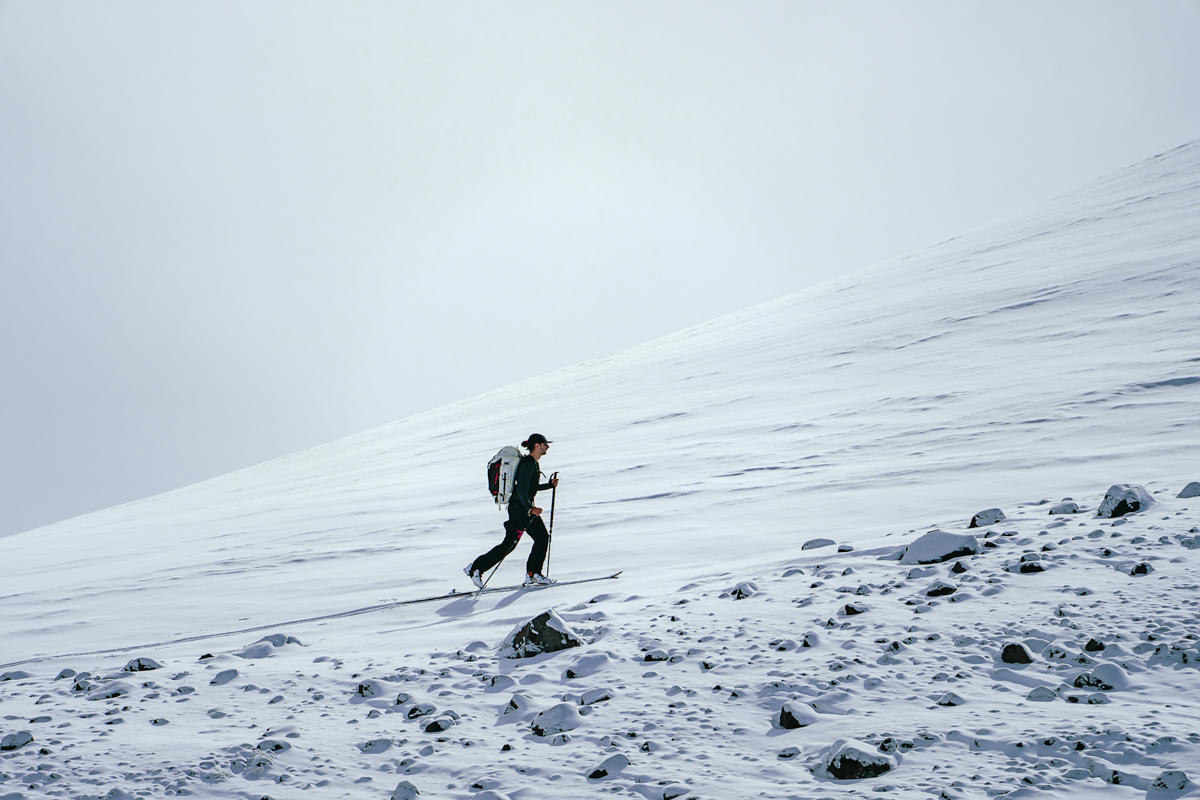
For traveling in the backcountry, skins are an essential piece of equipment. In short, they are strips of fabric—most often nylon or mohair (or a blend of the two)—that attach to the bottom of touring skis and allow you to climb uphill. The opposite side is an adhesive that sticks to the base of your ski, with attachment points at the tip and tail. To best illustrate how skins work, imagine petting a dog. When you move your hand in one direction, the fur feels soft and smooth. When you go against the grain, you likely feel some resistance. This resistance is what allows skiers to walk uphill without sliding backward. Alternatively, when you’re on flatter ground, the skins allow you to glide forward easily.
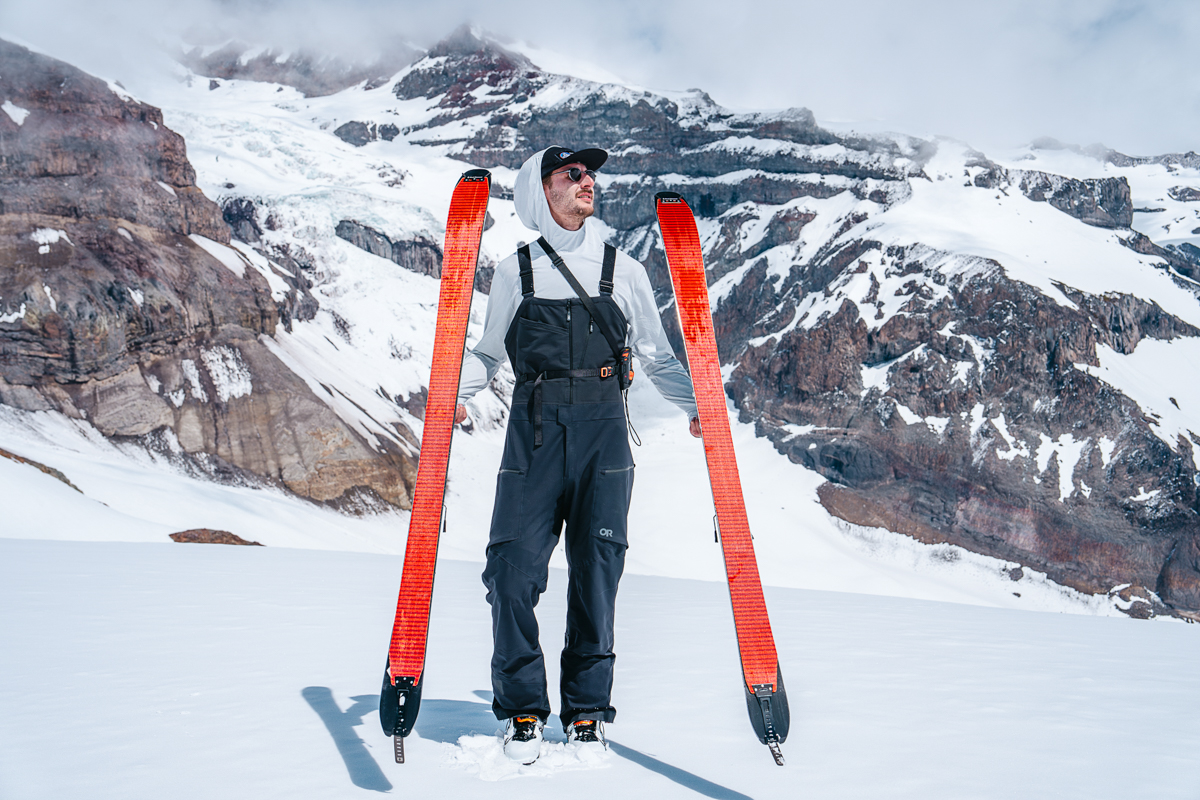
A key consideration in purchasing climbing skins is the plush material: Skins are made using nylon, mohair, or a combination of the two. Nylon and mohair skins work the same way, but the materials differ considerably in overall performance. An all-nylon skin like the Black Diamond Ascension will typically have excellent climbing abilities and provide grip in a variety of conditions. However, nylon is heavier, bulkier, and doesn’t glide as well as mohair. An all-mohair skin (made from the hair of Angora goats), on the other hand, is generally lightweight, packable, and able to maintain speed on flat sections. On the other hand, mohair doesn’t have the same sticking power as nylon—especially on steep skin tracks—suffers in wet snow, and tends to be pricier and less durable in the long run. In the end, our favorite skins use a blend—the Pomoca Tour Pro, for example, uses 65% mohair and 35% nylon to harness the performance benefits of both.
A final decision on skin material should come down to your skiing goals. Skimo and randonnée racers, as well as serious ski mountaineers aimed at traveling fast and light, should consider all-mohair skins. For skiers new to touring, we recommend choosing an all-nylon or mostly nylon skin for the lower price, better durability, and more secure feeling on the skin track. For seasoned backcountry-goers with good technique, mixed-material skins provide great overall performance both in straightaways and while traveling uphill.
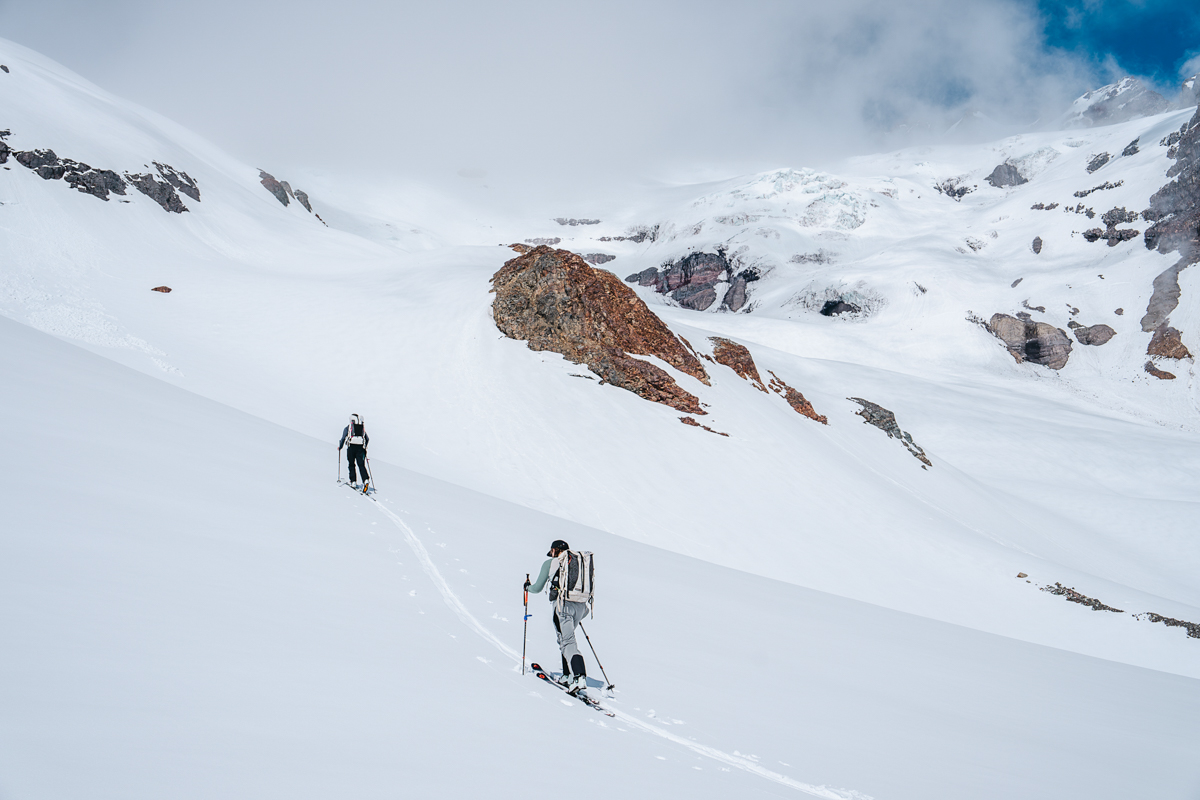
Skins have four important components worth breaking down: tip clip, tail clip, adhesive, and plush (fur). The tip and tail clips function just as their names imply: The tip clip keeps the front of the skin attached to the front of the ski, while the tail clip does the same at the back. The adhesive is what firmly sticks the skins to ski bases. And the plush—usually nylon or mohair—is what allows skis to travel both uphill and downhill on snow.
Tip and Tail Clips
Tip and tail clips vary in design depending on the manufacturer and model, and certain clips work best for certain ski shapes. Black Diamond and G3’s tail clips, for example, are most effective on skis with flat tails, and we especially love BD's STS system for it's easily replaceable design. In terms of tip attachments, G3's designs seem to work best for skis with wider shovels (they also sell twin-tip connectors for $21), while Black Diamond's tip clips come in two sizes depending on the width of the skin. Although certain skins are preferable for certain skis, all of the picks above are universal and will work well with most backcountry skis.
.jpg)
Adhesive
The adhesive on skins is what helps them stick to your ski bases. It’s typically made with a tacky glue, but the downside is that this glue can stick to other objects as well—such as dog fur, down feathers, or pine needles. Additionally, although it releases from ski bases relatively easily, when skins are stuck together (the appropriate storage method), it can often take a great deal of effort to pull them apart. In the end, dealing with stickiness is unavoidable (it’s certainly better than not enough adhesion), although some companies have invented small workarounds. G3’s skins have a non-sticky “Rip Strip” that runs down the center of each skin, and Contour’s Hybrid Mix features a combination of standard glue and a glueless technology.
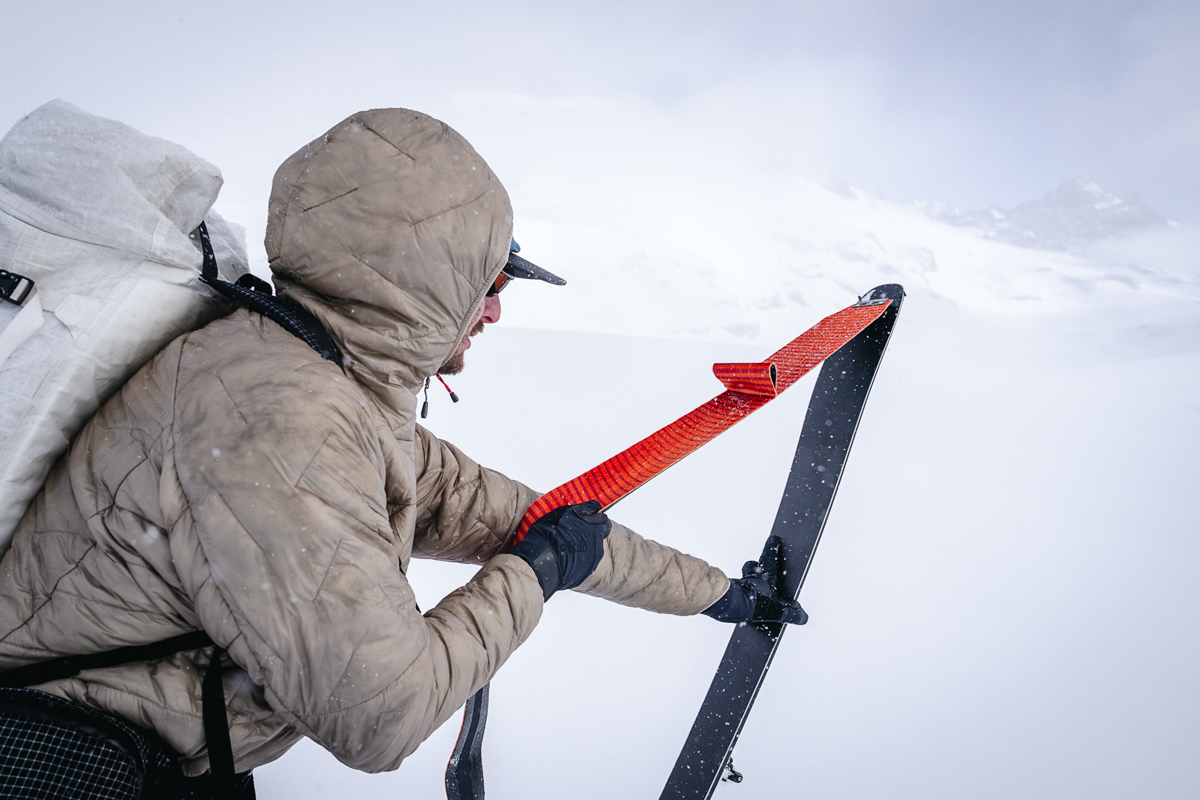
Plush (Fur)
Finally, and arguably most importantly, is the plush side of your skins (also referred to as “fur”). Typically made of nylon, mohair, or a blend of the two materials (often referred to as “momix”), the plush is what gives your skis the ability to climb up the skin track yet still glide on flat areas and slide down any downhill sections. Given the notable differences between the two materials, we've broken them down in-depth above.
Skin Width
Some skins come in varying widths (often in 10 to 15mm increments), while others are available in just one size (like the 133mm Black Diamond Ascension). When selecting your skin, the goal is to cover as much of the base as possible (just shy of the edges) for maximum grip. You’ll want to take into account the width of the widest part of your ski that touches the ground, not the underfoot width. For example, if your ski’s dimensions are 133/105/119mm, you should purchase a skin that’s at least 133mm wide. Some weight-conscious skiers prefer to use skinnier skins, but you’ll always want to cover the entire width underfoot (in the example above, this would mean going with a skin no smaller than 105mm). The biggest downside here is less traction (and it can be a fair amount), and whether that’s worth the tradeoff in weight is up to you.
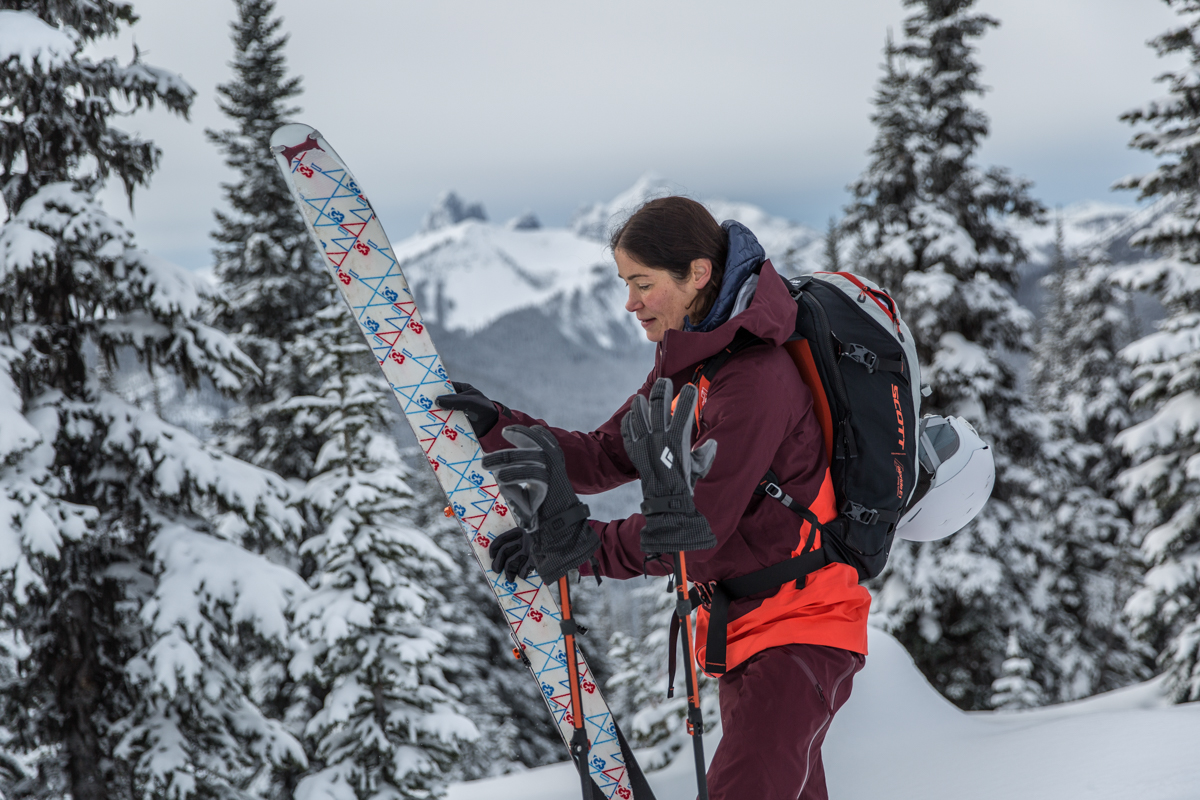
Skin Length
After determining skin width, it’s also important to nail the length. Most climbing skins are sold in different length ranges (with tip and tail attachments already installed), and you customize the fit via the varying adjustments on the tail clip. In this case, select the range that includes your skis’ length (e.g., if your skis are 165cm long, purchase the 162-172cm version of the skins). On the other hand, some models (like the G3 Escapist Universal) have limited length offerings (175 and 200cm for the G3), which means they’ll need to be cut to fit your skis. The process of cutting and attaching the tip clip is fairly straightforward, but if you’re uncomfortable with DIY, most ski shops will do it for a small fee.
Fitting Skins to Your Skis
Once you purchase the right length and width of skin, a few steps remain before you’re ready to hit the skin track. The most time-consuming portion is trimming the width, which must be done for all skins except for those custom-cut to specific skis. Included with your skin will be a trim tool and instructions for cutting your skins—keep in mind that you can’t un-cut a skin, so we recommend reading the manufacturer’s instructions and watching their videos online before trimming. In terms of the length, most modern skins come with preinstalled hardware, meaning no trimming is involved—just use the adjustable tail clip to fit the skin snugly on your ski.

The climbing skins above can be adapted to fit almost any skis, but it’s also possible to buy skins pre-cut for some popular backcountry models. For example, the Black Crows Pilus Camox Freebird skin comes in six lengths that are cut specifically for the six different sizes of their Camox Freebird ski. Because of their custom nature, these skins tend to run on the pricey side, but the convenience is well worth it for many.
On a similar note, the vast majority of precut skins are co-branded. Most skins are made by one of just a few manufactures, including Black Diamond, Pomoca, G3, and Contour, (Pomoca is responsible for DPS and Dynafit skins, while Contour makes Black Crows’ and Elan's offerings). Because of this, the information provided above can still be very helpful for those who decide to opt for custom-cut skins. For example, the Dynafit Speedskin series utilizes similar technology as Pomoca’s Climb Tour Pro, including the use of Pomoca’s beloved glue.
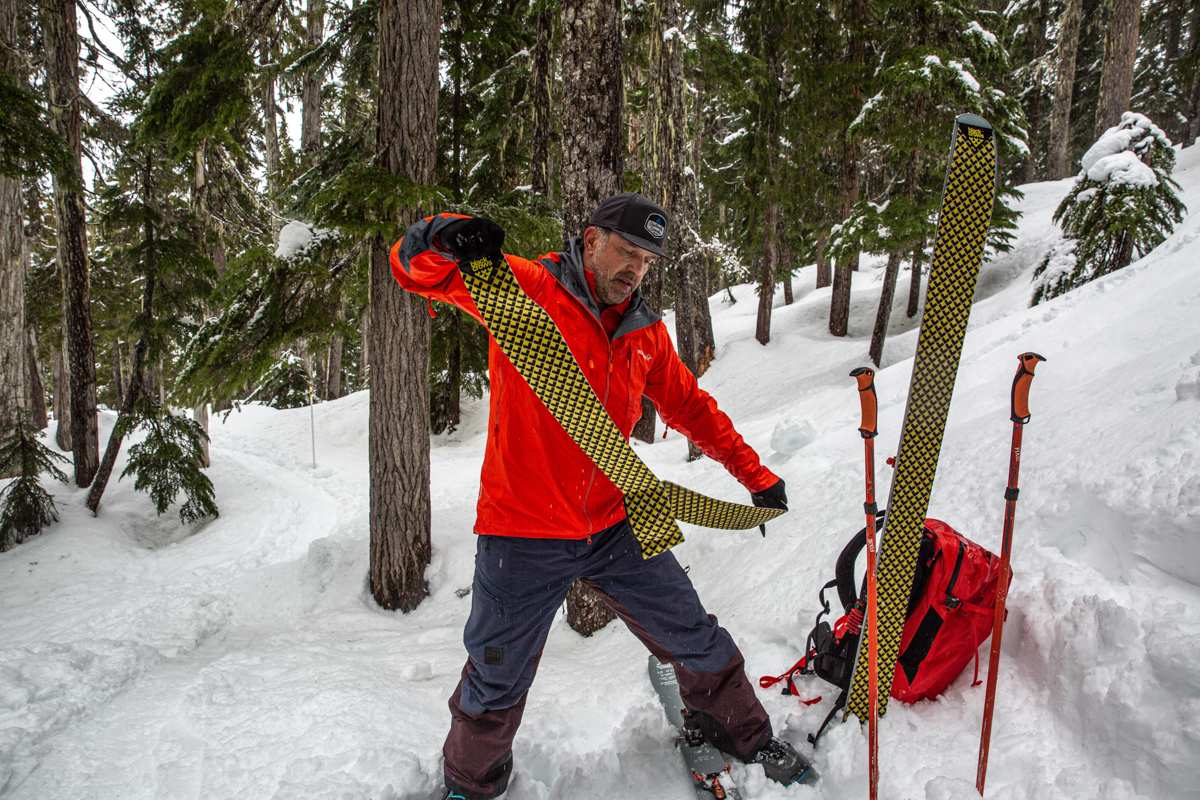
Caring for Your Skins While Touring
Your skins will have a better chance at lasting through a full day of touring if you take good care of them while you’re out there. The key is to keep your skins warm, dry (and free of snow), and to take the time to address any issues right away, before they become a day-ender. Before putting your skins on your skis, take a moment to brush your ski bases with a gloved hand to remove snow, ice, and other debris, and dry the bases as much as possible. Take your time to line up your skins and press them onto your bases each time you put them on—this will help keep them snow-free.
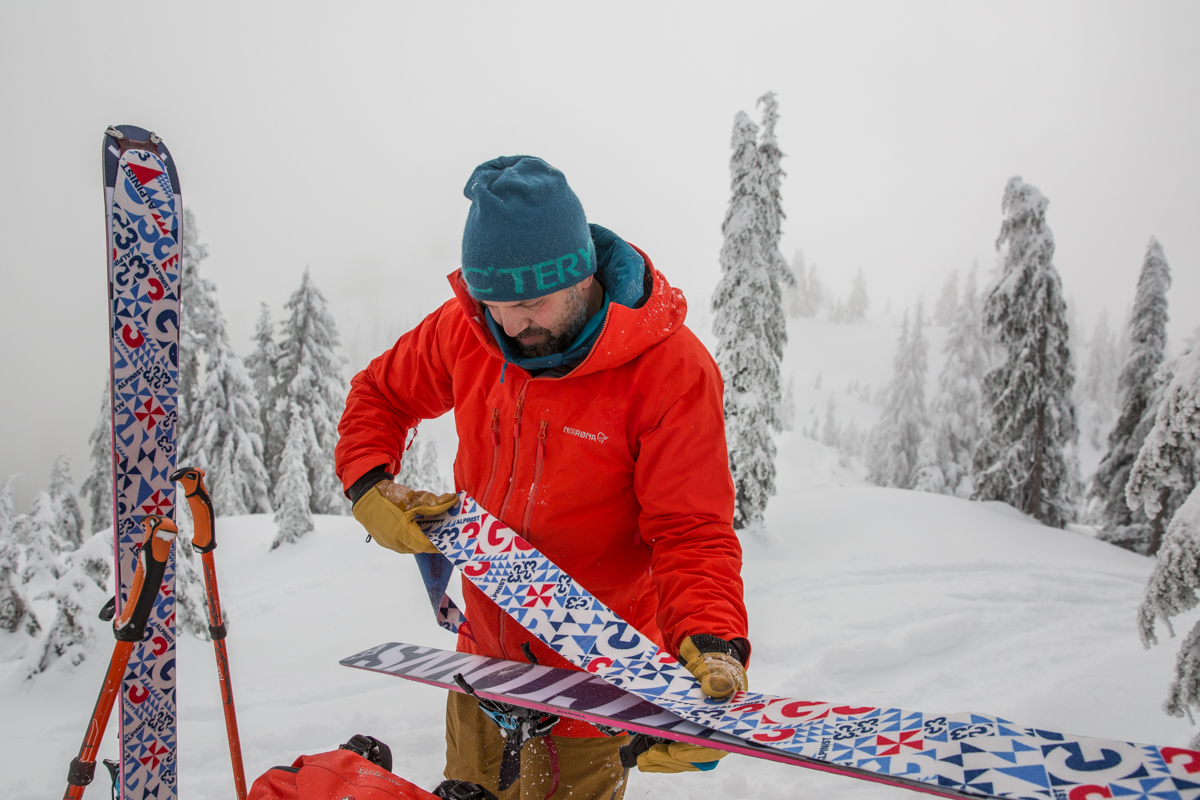
There are several techniques for taking your skins off your skis, and some are better than others depending on the conditions. The simplest way is to remove one ski and one skin at a time. Start from one end (usually the tail) and peel the skin off, folding it against itself in thirds (with the sticky sides together) as you move up the ski. By folding it as you go, you limit the chance for the glue to collect snow, debris, or to stick to itself (or you) while blowing around in the wind. Once it’s folded up, put the skin either into your ski pack or ski jacket before removing the other one. Keeping your skins in your jacket close to your core is a good way to keep them dry, warm, and properly sticky, especially when you’re doing multiple laps (and especially on cold, stormy days). As you get faster at transitioning, it’s also convenient to stuff your skins into your jacket and save yourself the time of taking your pack off at all.

How to Store Skins
In order to maximize lifespan, you’ll want to store your skins properly between tours and seasons. During the winter, it’s important to dry them out after each use—it may be easy to forget about your skins sitting in your ski pack or in the car, but if they’re left in a cold or wet location, they won’t perform well the next time you venture into the backcountry. We like to hang our skins indoors in a room that gets some airflow, ensuring that the glue is not touching anything that might dirty it. Additionally, don’t hang your skins near a heat source, like a fireplace or wall heater.
In the off-season or during any extended break from skiing, it’s a good idea to store the skins with the included skin savers. These are strips of mesh-like plastic that stick to the adhesive sides of your skins and are designed to protect and preserve the glue and keep off debris. To apply, smooth the mesh strips onto the skin adhesives and keep them either loosely folded in a bag or hanging in a dry space.
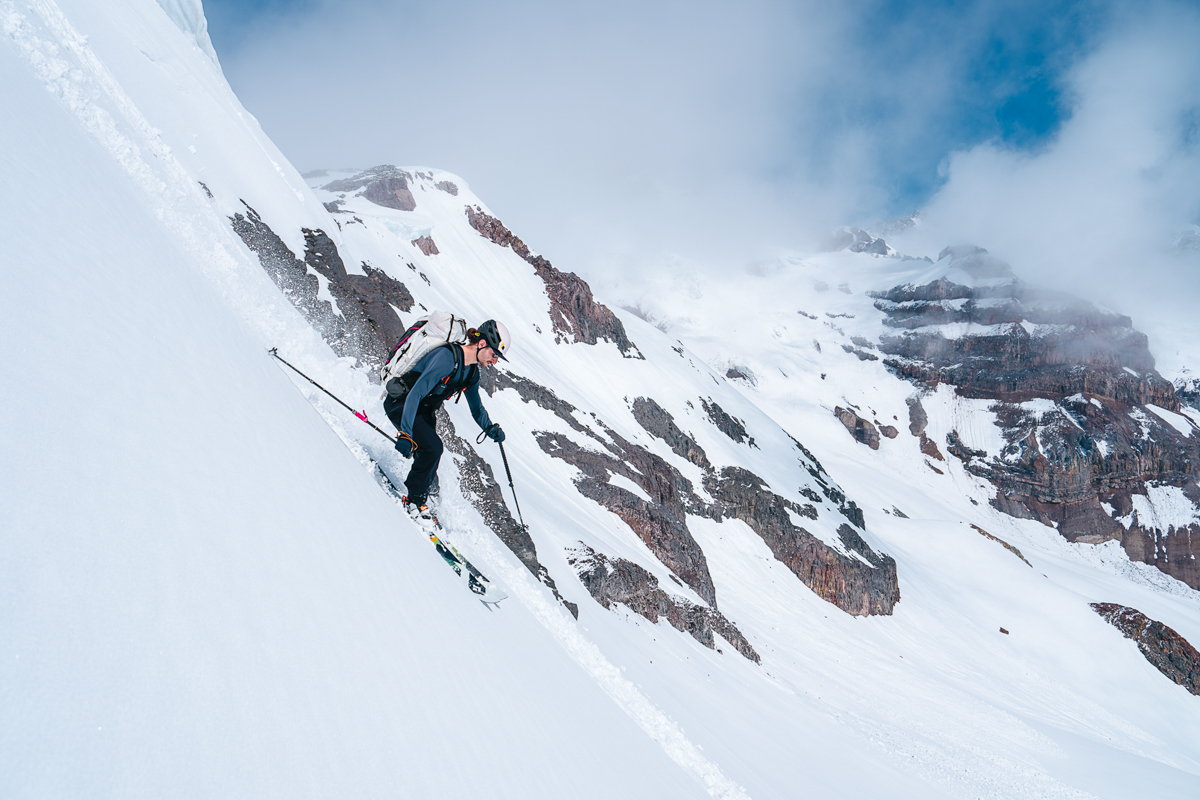
Adhesive Won’t Stick
There are two main reasons that the adhesive isn’t sticking to your touring skis: either it’s too cold, or your skins have a buildup of snow or ice. The best solution is to remove the skins from your skis and firmly rub the adhesive on your thigh or hip. You can also prop one of your skis vertically in the snow and use the edges to scrape snow off the skins. This friction should warm up the glue and knock off any lingering ice chunks. Before putting the skin back on, make sure your ski is also clear of snow and ice, and try drying it off with your ski glove or jacket sleeve. If the skins are still having trouble sticking, you can attach a ski strap around your ski and skin to give them a little more security (we keep a few ski straps in our pack for this purpose). To prevent this from happening in the future, make sure to store your skins in your jacket while you’re skiing and dry them out overnight.
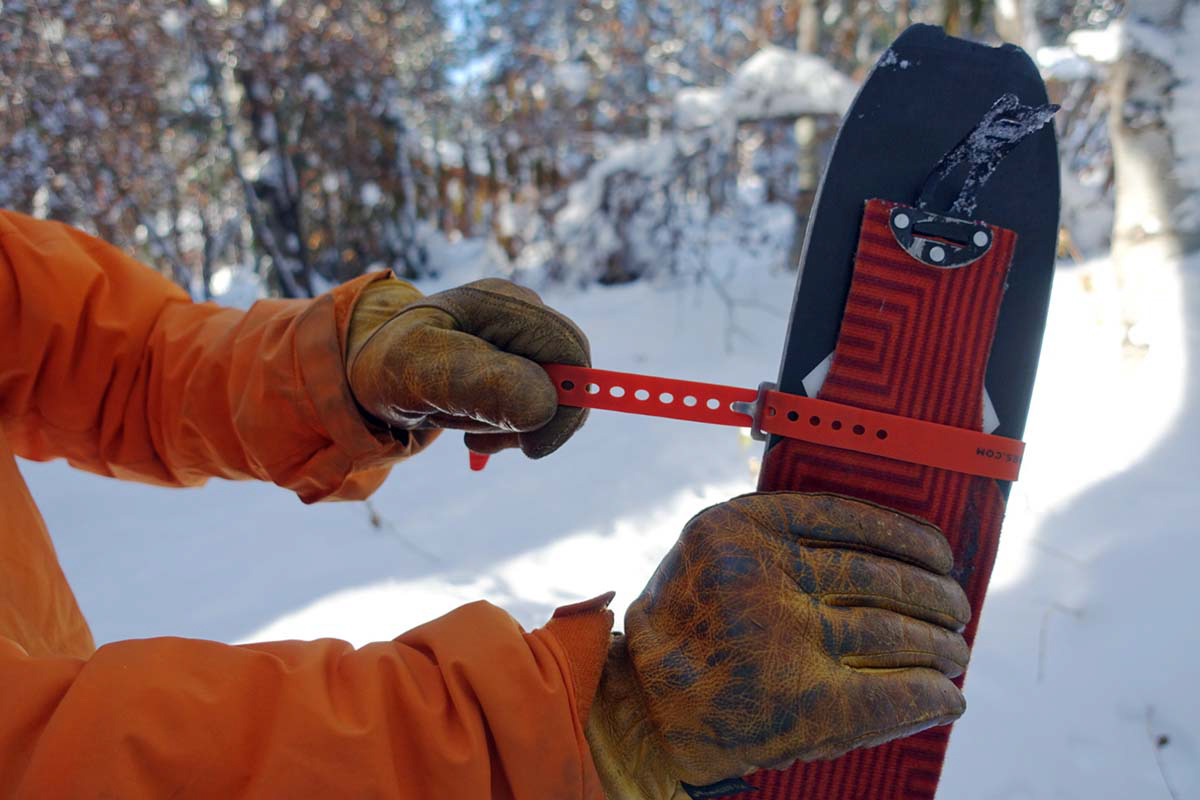
Skins Won't Glide
Skins can often feel extremely sticky on snow and won’t glide the way they should. This usually happens during warm spring days. In short, warm and wet snow can melt and re-freeze onto the skin plush, making it nearly impossible to glide and even harder to climb uphill. The best way to solve this problem is to shave off all snow and ice using the edge of your ski, then apply a special skin wax (like Black Diamond Glob Stopper) to the plush to help prevent further buildup. You can also apply this wax to your skins before heading out if you know temperatures will be near or above freezing.
Tail or Tip Clip Breaks
Some tail and tip hardware seems to last forever while others are a bit more susceptible to breaking. In particular, Pomoca tail clips are made of plastic, which isn’t as robust as the metal clips on G3 and Black Diamond skins. That said, no parts are invincible to snapping or tearing. Should one break, the easiest backcountry fix is to use a ski strap (the Voile Strap is our favorite) to keep your tips and tails joined to your ski bases until you’re done climbing for the day. Additionally, most brands sell replacement parts for their skins that are relatively inexpensive. Keeping a small repair kit in your ski pack with spare parts, a ski multi-tool, wire and hose clamp (for fixing a broken pole), and even some duct tape can make the difference in continuing your day or cutting it short.

If you’ve come here looking for splitboard skins, you might be disappointed not to see any specific options in the picks above (most of our staff are skiers, after all). But there’s still a lot to glean from our breakdown, including details on the pros and cons of nylon and mohair, how to properly size your skins, and the various glue types available. And while many of the brands mentioned above also make splitboard-specific skins (the Black Diamond Ascension Splitboard, for example), it’s a good idea to look at offerings from splitboarding companies in particular, including Jones (made by Pomoca), Nitro and Karakorum (both made by Kohla), and Spark R&D (made by G3). Like ski skins, splitboard skins are offered in both custom-cut and batch varieties, and most also come with pre-installed hardware.

Finding a good pair of climbing skins to pair with your backcountry skis is a great start to venturing past the ski lifts. In addition, you'll want to be sure to have a complete avalanche rescue toolkit, which includes an avalanche beacon, shovel, and probe (and proper training on how to use them—we recommend a Level 1 course from AIARE or the American Avalanche Institute). A ski backpack will also be essential for carrying your supplies. In terms of other clothing and equipment, we’ve compiled in-depth lists—many of which include backcountry-specific picks—for everything from ski helmets, goggles, and gloves to ski jackets and pants. Our backcountry skiing checklist is a great place to start, or you can check out all of our ski gear reviews here.
Back to Our Top Climbing Skin Picks Back to Our Climbing Skin Comparison Table